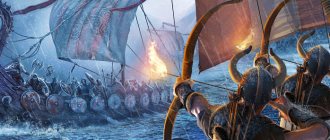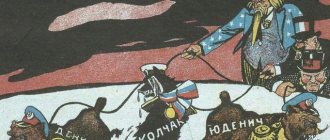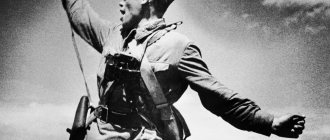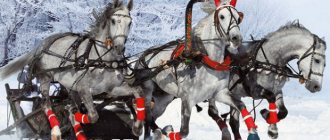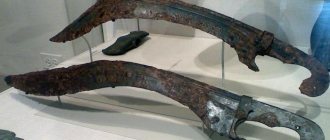Hello, dear readers of the KtoNaNovenkogo.ru blog. “What good can the Varangians do for us?” - this is what they say when people from “outside” are appointed to leadership positions.
Football fans mention these mysterious personalities and sing about them (“Our proud Varyag does not surrender to the enemy!”). Despite its popularity, the meaning of this word is shrouded in darkness.
To dispel it and understand who the Varangians are, you will have to start a time machine and go back to the depths of centuries. Forward!
Varangians - what kind of people are they and the meaning of the word
The term “Varangians” appeared in Rus' in the 11th century (it was known earlier in Byzantium and the Arab East). According to the Tale of Bygone Years, the oldest surviving chronicle, they played a significant role in the formation of the Russian state.
It was the calling of the Varangians to reign in Novgorod, which occurred in 862, that is considered to be the starting point of Russian history.
The meaning of the word “Varangians” is interpreted differently:
- In the sagas of the northern peoples, the word “væringjar” (Varangian) appears at the beginning of the 11th century in connection with the description of the Scandinavian service in Byzantium.
In this interpretation, the Varangians - these are mercenary warriors, allies who swore an oath of allegiance to the Byzantine emperor.There were such mercenaries in Rus': Prince Igor resorted to their help in the campaign of 943. The Varangian squad helped Vladimir Svyatoslavich seize the Kiev throne in 979.
- This is the general name for those who were engaged in sea robbery (from varg - “wolf”, “ robber ”).
- A Varangian is a daring merchant, sometimes difficult to distinguish from a robber. This version is supported by the word “varangit”, preserved in the Russian lexicon. In Imperial Russia it meant “engage in petty trading.” It was with the Varangians that the main trade route of the 9th-12th centuries, “the path from the Varangians to the Greeks,” .
- “Varya” was the name given to the process of boiling salt before taking it out for drying. The resulting salt was called brew. This is how some historians explain the fact that the Baltic Sea in ancient times was called the Varangian Sea - because of the salt industry that flourished on its coast.
- Derivation from Celtic var (water). Here we mean residents of the coast, in the Russian version - Pomors .
The Varangians, whether merchants, mercenary warriors or “dashing people”, willy-nilly found themselves in the territory inhabited by the Eastern Slavs, rushing to Byzantium. In the 8th - 11th centuries, this country attracted wealth and promised fabulous opportunities.
Tens of thousands of people passed through the Slavic lands from north to south and back along the route called by Nestor “ The Path from the Varangians to the Greeks and from the Greeks to... ”.
This water route, which ran from the Baltic Sea to the Byzantine lands, was the main route of trade and cultural exchange between northern and southern peoples until the Mongol invasion.
There is an opinion that the Varangians in Ancient Russia are a collective concept . It could refer to any “alien” people who appear for various purposes, be it trade, service as mercenaries, or pirate raids.
We are interested in the “narrow version”: who are the Varangians in Rus', who became the main characters in the formation of the Old Russian state?
Varangians: definition as peoples in Russian history
The concept of “Varangians” in Russia differs significantly from the definitions of Western scientists, who often identify them with the Vikings. Russian historians proceeded from the information contained in Nestor’s chronicle, although it was written 200 years after the events described.
In the Tale of Bygone Years, the word “Varangian” does not mean a specific people; this concept includes several peoples. The Varangians are the tribes of Rurik, called Rus, the Swedes are Svei, Normans, in our time they are called Norwegians, Angles, Goths - peoples who lived on the shores of the Baltic.
Russian historian Karamzin N.M. The word “Varangians” means the Scandinavian peoples. Some modern Russian historians also adhere to this version. But at different times, a number of researchers identified them with the Finns, Prussians, Slavs of the Baltic, as well as the Varangians of the salt (Russian) industries in the south of the Ilmen region.
Before the revolution, there was another cultural and political version, which was put forward by the German historian Johann Evers. She was accepted as official and had many followers. According to it, the Varangians are both northern Scandinavian peoples and southern ones - the ancestors of the Cossacks, descended from the Khazars. This theory had many followers. They, based on archaeological data and information from Nikon’s chronicle, went even further, arguing that the Varangians are a Slavic-Turkic people.
Calling of the Varangians
The history of Rus' begins with events in which the main characters are the Varangians. It was to them that the Slavic and Finnish tribes paid tribute in the middle of the 9th century. By 862, the Varangians were expelled, and the time had come for bloody civil strife.
Tired of senseless clashes, the Slavic nobility decided to look for the prince on the side, “overseas.” They turned “to the Varangians, to Rus',” colorfully describing their land as vast and abundant, but devoid of order.
The Varangian prince Rurik, who accepted the attractive offer, went overseas with his retinue and clan. Actually, from this moment the history of Russian statehood began.
At first, scientists treated the story about the calling of the Varangians with complete confidence, but over time it began to be questioned .
There is nothing about the legendary event either in Russian (except for the Tale of Bygone Years) or in Scandinavian sources. The latter only mentions mercenary warriors going to the country of Gardarik (as Rus' was called) and receiving generous rewards for their services.
At the beginning of the 20th century, historian A.A. Shakhmatov stated that the block on vocation was a later insertion . There is an opinion that this legend is included in the text in order to strengthen the independence of Rus' from the influence of Byzantium.
Upon careful reading of the chronicle, the story of vocation appears in a new light. An agreement (“row”) was concluded between the Slavic and Finnish tribal nobility and the Varangian princes.
It provided for the transfer of the powers of a manager to the summoned party on the terms of “to rule”, “to judge” (“to order”) according to law, according to a number of rules - in accordance with the norms of local law.
Today, many historians view the calling of the Varangians to Russia as a reflection of the contractual relations between the East Slavic and Finnish nobility, on the one hand, and the Varangian squad led by the prince (in modern terms, he acted as a top manager ) on the other.
The event, which became the starting point of Russian history, is also controversial because it is not completely clear what the Varangians called to Rus' are from an ethnic point of view.
Varangians in The Tale of Bygone Years
In this ancient chronicle, the earliest that has reached us, the Varangians are given a special place. It is with them that the formation of the Russian state is connected, since before the “calling of the Varangians” its territory was inhabited by scattered Slavic and Finno-Ugric tribes. After the Varangians from the Rus tribe were called up, this name was given to the state.
Rurik and his Rus tribe came at the call of the Slavic and Finno-Ugric tribes to the Novgorod lands in order to eradicate civil strife between the tribes. The formed state began to be called Russia. The chronicle describes where the Varangians lived. They were located on the Varangian Sea, west to the lands of England and Voloshskaya.
Most Russian scientists believe that in addition to real events, there are many exaggerations in the chronicle (the creation of the Russian state by the Varangians). Real events coexist with far-fetched ones; these include the waterway from the Greeks to the Varangians. Assuming that part of this route was overland. This is what makes many scientists consider it a fiction.
Scandinavian version of the origin of the Varangians (unsubstantiated)
The chronicled arrival of the Varangians “from across the sea” gave reason to consider them to be immigrants from Scandinavia, descendants of modern Swedes, Danes, and Norwegians. For a long time, the Scandinavian origin of the Varangians was considered proven.
Linguists have confirmed the Scandinavian roots of the names of representatives of the first ruling dynasty: Rurik, Oleg, Askold, Dir, Igor, Olga. During archaeological excavations at the Rurik settlement (this place near modern Veliky Novgorod), many Scandinavian artifacts were found - significantly more than Slavic ones.
The first international treaties, concluded in 911 by Oleg and in 944 by Igor, are also replete with Scandinavian names. “We are from the Russian family: Karls, Inegeld, Farlof, Veremud, Rulav...”
Confirmation of the Scandinavian origin of the summoned Varangians was found in foreign sources. Thus, the traveler Ibn Fadlan described in detail the burial ceremony of a noble Rus, traditional for Northern Europe.
The “Scandinavian” version formed the basis of the Norman theory, popular in the 1st half of the 18th century thanks to the German scientists G.Z. Bayer, G.F. Miller and A.L. Schletser.
According to this concept, before the calling of the Scandinavian Varangians, the Slavic tribes lived “in darkness”, having vague ideas about the state, culture and similar categories. The Scandinavians (they were also called “Normans” - northern people) practically created the Old Russian state and the Russian people.
The Norman theory in such a “hard” interpretation is today recognized as untenable , however, many historians consider the Scandinavian origin of the Varangians, who played a significant role in the history of Russian statehood, to be proven.
WHICH NOVGOROD WAS FOUNDED BY RURIK
Rurik-Yuri founded Novgorod on the Volkhov River. Everything is correct. Apparently, we are talking about Yaroslavl, located on the Volga River. VOLKHOV is probably one of the early names of VOLGA. And only then, when historians moved the name Novgorod to its modern place, the Volga name Volkhov also shifted and stuck to the river flowing through modern Novgorod. And this river began to be called Volkhov.
Similar publication: Historical geography of the ancient Russian epic
Geographical names moved and were duplicated. We have demonstrated this many times. However, it could have been different. The modern city of Novgorod was once founded by immigrants from Novgorod-Yaroslavl. They called the small river that flowed there with their usual name Volkhov, that is, Volga (from the word “moisture”?), and the city - Novgorod. This is what the emigrants of our era did when moving from Europe to America. In America there is the name Moscow, etc.
WHAT IS ILMER
Rurik-Yuri founded Novgorod near Ilmer. What is Ilmer? Just below the chronicle talks about the people of MER, whose capital was Rostov. And Rostov is very close to Yaroslavl.
Are the Varangians Slavs?
There is a point of view that the Varangians are in no way connected with the Scandinavian Vikings, who at the time of their historical vocation had a very vague idea of statehood .
They made predatory campaigns on Russian lands, but these campaigns were in the nature of short-term raids. Their rulers, called kings, were able to rule at most one tribe or village, but they certainly would not have been able to manage the state. In addition, Rurik, who was invited to reign, was called a prince, not a king.
Supporters of this version point to the southern coast of the Baltic as the place of settlement of the Varangians. In the 8th-9th centuries, after the Great Migration , Slavic peoples inhabited a significant part of Europe, had a similar culture, and understood each other’s language.
Ambassador Sigismund Herberstein, who visited Moscow at the beginning of the 16th century, argued that the homeland of the Varangians was Vagria, which was located on the southern Baltic coast.
According to the “Slavic” version, sending ambassadors to the people called “Varyag-Rus” by the chronicler was an appeal to distant relatives . Therefore, there is no mention in the sources of a language barrier between the summoned Varangians and the Slavs.
The debate about who the Varangians called to Rus' were continues. It is possible that even if historians had the opportunity to turn to Nestor the Chronicler himself: “Explain the meaning of the word Varangians!”, they would receive a streamlined answer.
After all, “The Tale of Bygone Years” offers different options, first interpreting the concept of “Varangians” on the basis of territorial settlement, then hinting that it was a separate ethnic group, ultimately moving to a multi-ethnic version.
The Varangians (this definition, apparently, was used in a broad sense to designate alien warriors, merchants, princes), regardless of ethnicity, played a significant role in the formation of the Old Russian state, but it would be wrong to exaggerate it.
The conditions for the formation of a state among the Eastern Slavs had developed even before the legendary calling.
Establishment of Varangian rule in Rus'
If you believe ancient sources, the Varangians, after forming armed trading clans in the cities, began to gradually seize power into their own hands. Over time, the cities, which were ruled by the Varangian princes, turned into powerful armed centers around which the local population was grouped. Since before this the Slavs were under the yoke of the Khazars and paid them tribute, the unauthorized seizure of power by the Varangians was regarded by the local population almost as deliverance.
The Varangian princes, unlike the greedy Khazars, did not rob local residents. The Tale of Bygone Years tells that the princes Askold and Dir, having approached Kyiv and learned that the local residents were paying tribute to the Khazars, remained to rule there. Then they recruited a strong army, consisting mainly of fellow tribesmen, and began to capture the nearby Polyana towns. Soon all these lands recognized the power of the Varangian princes.
Prince Oleg, who seized power in Kyiv, called all the surrounding Varangians and local glades to arms, and began to further expand his sphere of influence. So he managed to subjugate the Smolensk Krivichi. The local residents did not particularly resist, although the same Drevlyans for a long time did not want to obey the Varangians.
Modern Varangians
The word “Varyags” did not go into oblivion along with this mysterious people; it is still used today – in meanings close to the original ones.
In football, this is the name given to foreign players who play for a team not from their national championship.
This kind of “migration” (what is it?) has become a common occurrence; every championship has rules stipulating the permissible number of “Varangians” on the field.
The “Varangian phenomenon” has spread in personnel policy – the appointment of regional leaders from outside. There are also “half-Varangians” - natives of their region who have long lost contact with it.
Such appointments happen for a reason:
- When the local elite is split, unable to propose its own candidacy for the highest regional post.
- If there is a high level of corruption in the region, and local candidates are somehow involved in it.
- Alien leaders may be appointed to correct the crisis situation in the region.
- It happens that you need to “attach” a significant figure from the capital.
A leader “from the outside,” as a rule, brings with him a team of like-minded people, so the calling of the Varangians becomes similar to the chronicle version: the prince comes “with a squad and a house .
Warriors of the North
Before moving on to describing the history of the Russian Varangians, it is necessary to determine who these harsh warriors of the North were and why they appeared in Rus'.
The etymology of the word “Viking” (Danish vikinger, Swedish vikingar, Norse vikingene, Icelandic Víkingar) is quite simple. This term was used to describe people who went on summer military expeditions for booty under the leadership of kings.
This was primarily due to the natural conditions in which the Scandinavians had to live. The land of the Scandinavian Peninsula is not too fertile to support large numbers of people. In addition, life by the sea left its mark on the lifestyle of warriors, who were accustomed to traveling from childhood.
Most often, Viking detachments were formed from landless members of the community, for whom war was hardly the only financial support. Before the campaign, the warriors held meetings at which they determined the direction of the expedition, as well as how much was owed to whom from the total amount of booty. Later, this practice would become common among pirates.
Possessing excellent seaworthiness, the Vikings could not fear competition from neighboring peoples, as well as for their families, left without protection. Military raids were always one-sided; mainland residents only defended themselves or paid off invaders who had more military experience than them.
In addition to military campaigns, the Scandinavians today are known for their interesting religion, described in detail by researchers. Its study allows us to better understand the worldview of medieval warriors, their values and ideas about the world around them.
The Vikings traveled to the outside world on longships - wooden and narrow ships built from oak, pine or ash.
Their main weapons were spears, swords and axes, while any warrior wore chain mail or full armor.
Collectively, as the reader can see, the Vikings were fully prepared to be first-class bandits.
Interesting facts about the Varangians and Vikings from Pravmir:
- The legendary Varangians were such good warriors that they often became mercenary squads for the picky Byzantine emperors.
- According to the chronicles, the ships of the Varangian detachment were made only of oak. Therefore, they served for a long time and were famous for their durability.
- For the British of that time, the Varangians were inextricably linked with cleanliness and neatness: they washed themselves once a week!
- Despite the fact that the Norman campaigns were famous for their belligerence and harsh pressure, many of them traded. There is a lot of chronicle evidence about the trade of the Normans. There were also those involved in agriculture.
- Many historians identify the Varangians with... The invention of skis! After all, they traditionally lived in an area with a cold and snowy climate, so they were looking for a suitable means of transportation.
Version A.G. Kuzmina
Soviet and Russian scientist, historian and publicist, A.G. Kuzmin, the author of many works on the origins of Ancient Rus', took the position of anti-Normanism. He believed that the Varangians were the tribes that inhabited Vagria. They were called “vars”, “vagrs”, “varins”. Today Wagria is the name given to the peninsula located in the east of Schleswig-Holstein in Germany.
In the Middle Ages, this was the name given to lands spread over a much larger territory. As the Slavic Encyclopedia says, Vagria is the historical name of the region located between the Baltic Sea, the island of Fehmarn, the rivers Sventina and Trava. Since the 10th century, it was subjected to numerous ruinous raids by German feudal lords, and at the beginning of the 12th century it was captured by them.
According to A.G. Kuzmin, after the inhabitants of Vagria, the Varangians began to be called the entire set of Slavic peoples who lived on the southern shores of the Baltic Sea, that is, from Polish Pomerania to Vagria itself inclusive. And even later, other inhabitants of Europe who were subjects of the Frankish kings were also named this way.
Thus, there is no clear answer about the origin of the Varangians and their role in the formation of the Russian state today, but scientists continue their painstaking work.
Conquest of Kyiv and creation of the principality
The name of Prince Oleg is associated with the conquest of Kyiv, which became the center of the possessions of the Rurik dynasty.
He organized his campaign against the future capital city three years after the death of Rurik, in 882.
Kyiv was captured by Oleg by deception: he managed to lure the local princes into negotiations and then kill them. After this, he declared the city the center of his princely possessions, but did not forget Novgorod, which had to pay a large tribute for the maintenance of the Varangian squad.
Having settled in Kyiv, Oleg attacked his neighbors. He conquered the Drevlyans (883), the Northerners (884), and the Radimichi (885). Thus, he established himself throughout the Russian land.
In 907, the Kiev prince felt so strong that he set out to conquer Constantinople. It is interesting that the Greeks chose to buy off the strong Varangian army, although Byzantium was a fairly strong state.
It is also known that Oleg quite successfully fought with the Khazars and Arabs, although he did not conquer the Khazar Kaganate.
His successor, Rurik's son Igor, actually continued the work of his father and guardian. However, his successes were much more modest. In 944 he appears near Constantinople and besieges the city. As in the case of Oleg, the Byzantines preferred to buy off the next invasion. We are not aware of other actions of the prince. The new Kiev prince dies at a fairly young age at the hands of the conquered Drevlyan tribe, outraged by the excessive demands of the Varangians.
The most militant prince from the new dynasty is Svyatoslav. He is known to us for his campaigns against Byzantium and Bulgaria, the conquest of the Khazar Khaganate. The prince spent his entire life in the saddle; he rarely appeared in Kyiv, preferring long hikes.
Thus, three Varangian princes in a relatively short period of time created a huge state from the conquered peoples. At the same time, they followed the example of their Western brothers, who showed themselves in a similar way in Normandy, England, and Sicily. Everywhere, the military experience of the Vikings brought them quick successes in the military field, and weak nations looked to them for patrons. At the same time, the Scandinavians had a huge influence on the formation of local military culture.
What is the Norman theory? Arguments of Normanists and Anti-Normanists
The Norman theory is a direction in historiography that connects the origin of statehood in Rus' with the Varangians. In its most simplified and “radical” form, it is reduced to the assertion that the state of Rus' was created by immigrants from Sweden. Supporters of the Norman theory are called Normanists, opponents - anti-Normanists. The great Russian scientist Mikhail Lomonosov was an active anti-Normanist, who saw in this theory an attempt to substantiate the idea of the “backwardness” of the Slavs.
The main arguments of the Normanists were: the chronicle message about the calling of Rurik; Scandinavian names of princes and ambassadors to Byzantium; Scandinavian origin of the word "Rus".
Anti-Normanists objected that a state cannot be created from the outside without the absence of prerequisites. They cited evidence from the chronicle about the presence of large tribal associations, cities, and princely power among the Slavs.
Currently, the “Norman problem” in science is considered solved. Historians, archaeologists and linguists note that the Scandinavians played a prominent role in the history of Ancient Rus'. At the same time, no one claims that Russian statehood appeared solely thanks to the Varangians.
“By the end of the 19th century, there were practically no opponents of the Norman theory left, anti-Normanism died a natural death,” explains Fyodor Uspensky, “and its revival became possible only under the conditions of the Stalinist dictatorship - it was caused by the rejection of Nazi propaganda of the racial superiority of the Germans over the Slavs. However, this revival was and remains temporary and is explained solely by issues of ideology.”

